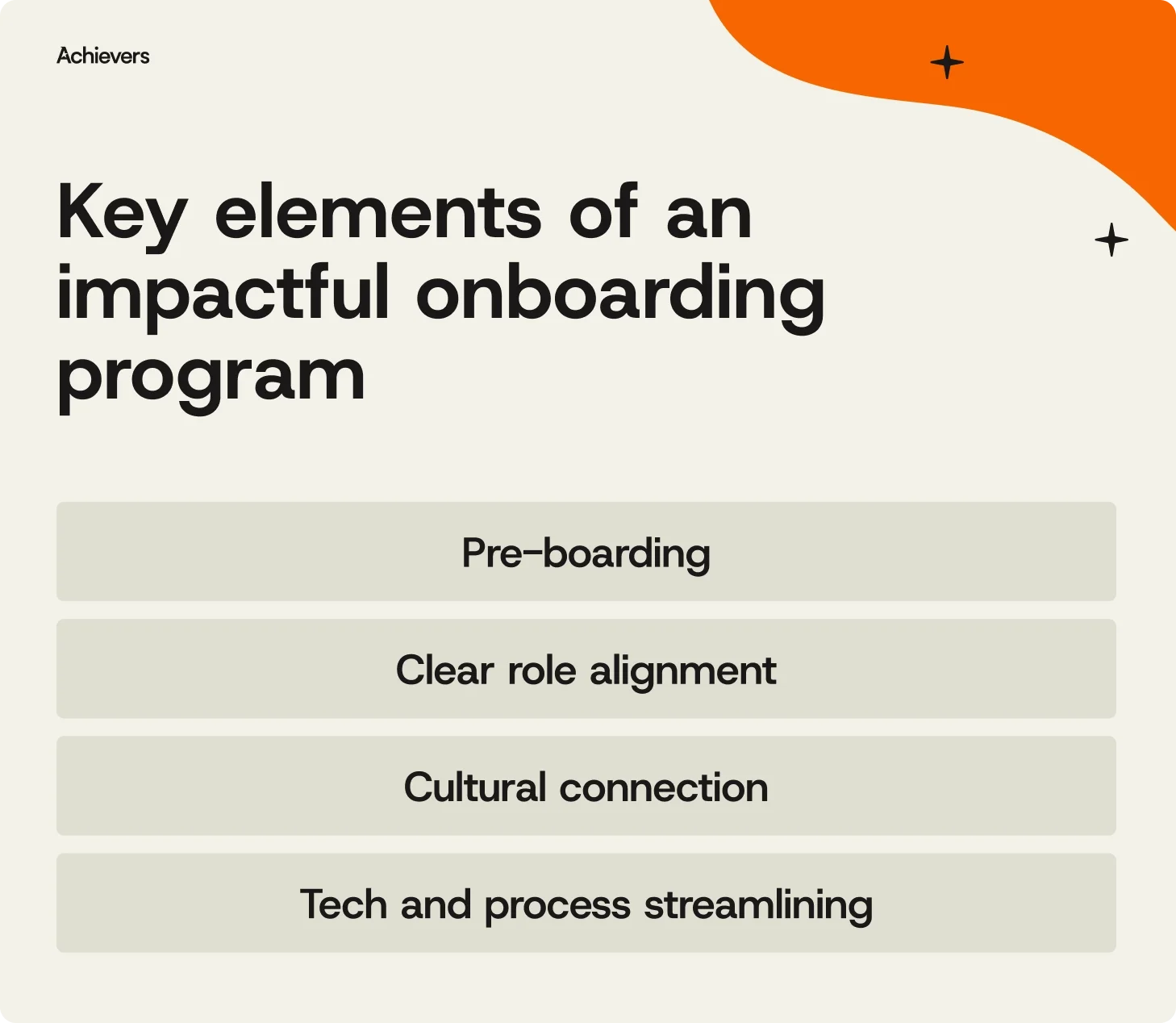Table of contents
Onboarding isn’t just about handing over a laptop and pointing out the coffee machine. It’s the moment where first impressions take root — and where a company begins to shape its workforce.
Done right, onboarding sets the tone for everything that follows. It’s how you give new hires more than a warm welcome — you give them clarity, confidence, and a genuine sense of belonging. The kind that says: you matter here.
And here’s something worth noting: companies with effective onboarding practices see up to 82% higher new hire retention. That’s not just a stat — that’s your future high performer choosing to stay because you set them up for success from day one.
When you invest in the first 365 days, you’re not just checking a box — you’re laying the groundwork for long-term impact. Productivity picks up. Culture clicks. Employees don’t just get to work — they get why their work matters.
In this blog, we’ll walk you through how to create an onboarding experience that’s simple, smart, and scalable. Ready? Let’s go!
Why onboarding matters beyond day one
Onboarding doesn’t end once the paperwork’s signed and the office tour wraps. It’s not a one-and-done task — it’s the launchpad for long-term employee success.
The smartest organizations know that onboarding is no longer just about forms and logins. It’s a strategic experience designed to build connections, boost confidence, and drive real engagement. And it shouldn’t stop after week one.
Extending onboarding through the first year means employees get the guidance, feedback, and support they need to thrive — not just survive. The result? Lower turnover, higher performance, and a workforce that actually wants to stay. Imagine that.
What makes onboarding actually work
Welcoming new hires is just the start. A standout onboarding program does more than hand over a badge and a few passwords — it lays the groundwork for lasting engagement, performance, and retention.
The goal? Help employees feel ready, recognized, and genuinely part of the team (ideally before their second coffee).
Here are the essentials behind an onboarding experience that actually works — not just in theory, but in real life:

Pre-boarding: The welcome starts before day one
The first day doesn’t start on the first day. Pre-boarding is your chance to roll out the red carpet early — helping new hires feel confident, connected, and yes, a little bit excited. Whether it’s a quick welcome video, a team intro, or a kit full of company swag and login details, small gestures make a big impact. Give employees the tools and info they need ahead of time, and you’ll cut the first-day nerves while setting the tone for what’s next: a smooth, supportive, and standout onboarding experience.
Clear role alignment: No guessing games, please
Nothing throws a wrench into a new hire’s momentum like fuzzy expectations. Role clarity isn’t just helpful — it’s foundational. Clear responsibilities, goals, and feedback loops help new employees understand what success looks like and how to get there. Add in a mentor or buddy for some early guidance, and you’ve got a recipe for faster ramp-up, stronger confidence, and far fewer “Wait, am I supposed to do that?” moments. Because let’s face it — ambiguity isn’t onboarding’s best friend.
Cultural connection: More than a job, it’s a fit
Joining a new company shouldn’t feel like walking into a room mid-conversation. Onboarding is your chance to help people connect — not just to their roles, but to your purpose, values, and culture. From storytelling and shared traditions to peer recognition (hi, Achievers platform), a strong cultural connection helps new hires feel like they belong — and that what they do matters. When employees feel part of something bigger, engagement follows. And let’s be honest — no one gets inspired by a mission statement buried on page 47 of the handbook.
Tech and process streamlining: Make it seamless
If it takes three hours and a scavenger hunt to access the intranet, we’ve got a problem. A smooth onboarding experience depends on tech and processes that just work. From system access to training tools, everything should be in one place — simple, central, and stress-free. Platforms like Achievers help new hires find what they need, track progress, and get rolling without a dozen help desk tickets. When the tech flows, the learning does too — and employees can focus on getting up to speed, not figuring out who to email for a password reset.
Proving onboarding works (with actual numbers)
You can’t improve what you don’t measure — and onboarding is no exception. Tracking the right metrics helps you see what’s working, what’s not, and where to tweak the experience so new hires don’t just survive their first year — they thrive in it.
Here are a few onboarding metrics worth watching:
- Time-to-productivity: How fast are new hires hitting their stride? A shorter ramp-up means your onboarding is doing its job: setting people up to contribute confidently and quickly. According to SHRM, effective onboarding can shave months off a new hire’s time-to-productivity.
- New hire satisfaction: What do new employees really think of their first few weeks? (Spoiler: they’ll tell you if you ask.) High satisfaction scores are a strong indicator your onboarding experience is working. A Harvard Business Review article found that only 52% of new hires feel satisfied with their onboarding experience, with 32% finding it confusing, and 22% disorganized.
- First-year retention: Still the gold standard. A report shows that 37.9% of employees who leave a company do so within their first year — and two-thirds of those exits happen within the first six months. That’s a clear signal: if onboarding misses the mark, your new hires might not stick around to see month seven.
Bottom line? Great onboarding isn’t a hunch — it’s a habit backed by data. And the best way to shape your workforce is to start with an onboarding process you can measure, learn from, and keep improving.
Overcoming the usual onboarding hiccups (you’re not alone)
Onboarding is where employee engagement begins — and where it can just as easily stall. From information overload to inconsistent experiences, even the best companies hit a few bumps in the road. The good news? Every challenge has a fix.
Here are five common onboarding obstacles — and what to do instead:
Challenge #1: Fire hosing new hires with information
Drowning people in policies, org charts, and process docs on day one doesn’t make them smarter. It makes them stressed.
Fix: Pace it out
Break onboarding into digestible phases. Start with the essentials — like tools, team intros, and company culture — and gradually layer in the details. The goal isn’t to cram — it’s to build confidence, one clear step at a time.
Challenge #2: One-size-fits-none onboarding
A generic onboarding experience can leave new hires wondering what exactly they signed up for.
Fix: Personalize by role
Create tailored pathways for each function. Engineers need different tools than marketers. Sales teams need product training; finance folks need… well, spreadsheets. When onboarding is relevant, it’s also more effective.
Challenge #3: Remote and hybrid hires feeling disconnected
Out of sight shouldn’t mean out of mind — but it often does.
Fix: Bring connection online
Use tools like Achievers to keep communication and recognition flowing across locations. Celebrate wins, share shoutouts, and make sure remote hires feel seen — even if their commute is just to the kitchen.
Challenge #4: Fuzzy expectations
When no one’s sure what success looks like, it’s hard to feel like you’re succeeding.
Fix: Set goals early and clearly
Outline key responsibilities and short-term objectives upfront. Add regular check-ins, and you’ve got a recipe for accountability and encouragement — which, turns out, go great together.
Challenge #5: Inconsistent onboarding across teams
If every department is running their own onboarding playbook, things get messy fast.
Fix: Standardize the core, customize the rest
Build a shared onboarding framework across the org, then let teams personalize the parts that matter to their roles. That way, every employee gets the same welcome — just with the right flavor for their job.
Ready for success: Onboarding that sticks (around)
Great onboarding isn’t a one-day event — it’s a year-long experience that helps new hires feel equipped, engaged, and excited to stay. When you go beyond the basics, employees don’t just show up — they lean in.
That’s where Achievers comes in.
With Achievers, you can celebrate wins early and often, building a culture of appreciation that makes people feel like they belong (because they do). And you can offer meaningful, motivating rewards tied to real achievements — not just anniversaries and all-hands shoutouts.
From day one to year one, Achievers helps you shape a more connected, confident, and committed workforce — one recognition, one reward, and one new hire at a time.
Ready to make onboarding work harder (and smarter) for you? Let’s do it.



